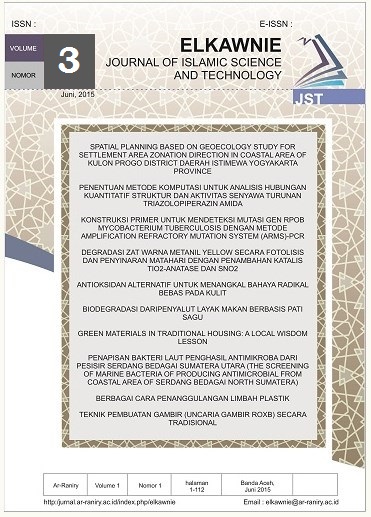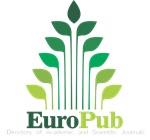Apikasi Fotodegradasi Nanokomposit Arang Aktif Tandan Kosong Kelapa Sawit/TiO2 Terhadap Limbah Cair Kelapa Sawit
DOI:
https://doi.org/10.22373/ekw.v3i2.2092Keywords:
karbon aktif, TiO2, fotodegradasiAbstract
Salah satu upaya yang dapat dilakukan untuk mengolah limbah cair kelapa sawit adalah menggunakan nanokomposit karbon aktif/TiO2 dengan metode adsorbsi-fotodegradasi. Metode adsorbsi-fotodegradasi didasarkan pada proses adsorbsi senyawa organik oleh permukaan padatan yang sekaligus mampu mendegradasi senyawa organik. Pada penelitian ini bertujuan untuk menguji kinerja nanokomposit karbon aktif/TiO2 dalam mendegradasi limbah cair kelapa sawit. Karbon aktif/ TiO2 hasil sintesis dikarakterisasi menggunakan spektrofotometer XRD dan SEM kemudian dilanjutkan pengujian aktivitas fotodegradasi dari sampel karbon aktif/ TiO2 dibawah sinar matahari dengan parameter nilai BOD. Hasil difraktogram sinar-X menunjukkan bahwa nanopartikel TiO2 memiliki ukuran kristalit sebesar 79,6 nm sehingga dapat diasumsikan bahwa partikel tersebut bersifat single kristal. Analisis foto SEM memperlihatkan morfologi partikel TiO2 berupa gumpalan putih yang tersebar tidak merata dipermukaan karbon aktif yang berbentuk batangan berpori dengan ukuran yang tidak seragam. Hasil pengujian aktivitas fotodegradasi menunjukkan bahwa nanokomposit karbon aktif/ TiO2 mampu menurunkan nilai BOD dari limbah cair kelapa sawit melalui mekanisme adsorbsi-fotodegradasi. Nilai BOD dari sampel karbon aktif/ TiO2 secara berurutan adalah sebagai berikut Sampel A (45,30 mg/L); Sampel B (67,65 mg/L), Sampel C (22,95 mg/L), Sampel D (22,95 mg/L) dan Sampel E (0,60 mg/L).References
Alam M Z., Muyibi S A., and Mansor M. F. 2007. Activated carbons derived from oilpalm empty-fruit bunches: Application to environmental problems. J. EnvironSci, 17: 103–108.
Alkhatib, M.A., Muyibi, S., and Amode, J., 2011, Optimization of activated carbon production from empty fruit bunch fibers in one-step steam pyrolysis for cadmium removal from aqueous solution, The Environmentalist, 31: 349.
Ameena, Y.K. 2003.Titanium Dioxide Coated Activated Carbon: A Regenerative Technology For Water Recovery, University Of Florida.
Benedix R, Dehn F, Quass J, Orgass M. 2000. Application of titanium dioxide photocatalysis to create self-cleaning building materials. Leipzig Annual Civil Engineering Report LACER No.5. Universität Leipzig, Leipzig, Germany, pp 157–167.
Chen, Xiaobo, and Samuel S. Mao. 2007. Titanium dioxide nanomaterials: synthesis, properties, modifications, and applications. Chemical reviews 107.7, 2891-2959.
Dahlan, Dahyunir.,Pravita, Anggi S., 2013. Analisis Sifat Hidrofobik dan Sifat Optik Lapisan Tipis TiO2, FMIPA Universitas Lampung.
Devi, B. V., Jahargidar, A. A. and Ahmed M. N. Z., 2012, Adsorption of Chromium onActivated Carbon Prepared from Coconut Shell, Int. J. Eng. ResearchApplications, Vol. 2 (5) : 364-370.
Fujishima A, Hashimoto K, Watanabe T. 1999. TiO2 photocatalysis – fundamentals and applications. BKC, Tokyo.
Hidayu,A.R., Mohammad, N.F., Matali, S., Sharifah, A.S.A.K., 2013, Characterization of Activated Carbon Prepared From Oil Palm Empty Fruit Bunch Using BET and FT-IR Techniques. Procedia Engineering. 379-384.
Ming,C.L, Joug.N.C, Kuo.T.C., 1999. Effect of Adsorbents Coated With Titanium Dioxide On The Photocatalytic Degradation Of Propoxur. Elsevier Science. Vol. 38 : 617-627.
Petrus,N.R, 2009, Studi Banding Teknologi Pengolahan Limbah Cair Kelapa Pabrik Kelapa Sawit, J. TeknikLingkungan, Vol. 10: 09 – 18.
Downloads
Published
Issue
Section
License
Proposed Policy for Journals That Offer Open Access Authors who publish with the Elkawnie journal agree to the following terms:
a. Authors retain copyright and grant the journal right of first publication with the work simultaneously licensed under a Creative Commons Attribution License that allows others to share the work with an acknowledgement of the work's authorship and initial publication in this journal.
b. Authors are able to enter into separate, additional contractual arrangements for the non-exclusive distribution of the journal's published version of the work (e.g., post it to an institutional repository or publish it in a book), with an acknowledgement of its initial publication in this journal.
c. Authors are permitted and encouraged to post their work online (e.g., in institutional repositories or on their website) prior to and during the submission process, as it can lead to productive exchanges, as well as earlier and greater citation of published work (see The Effect of Open Access).

























